 Leading Blog | Posts by Month |
 Leading Blog | Posts by Month |
07.31.23

LeadershipNow 140: July 2023 Compilation
See more on
Posted by Michael McKinney at 07:35 AM
07.28.23

Calling Out Unconscious Bias in the Workplace – Transcending the Problem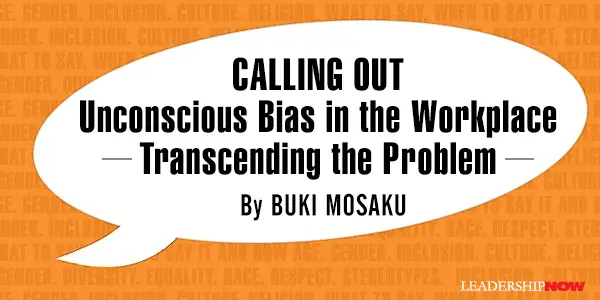
STATISTICS show that minorities and marginalized groups repeatedly experience career-stifling unconscious bias at many points throughout their working lives. Women and ethnic monitories, for example, often find it hard to climb the career ladder — a fact borne out in the significant underrepresentation of both groups in senior leadership roles. Minorities also report being passed over in favor of white or male counterparts when the “good” assignments are given out. They’re also less likely to be given access to the multitude of career development opportunities that make a difference in earning potential. Across sectors, minorities report that they:
Certainly, many employers have taken some important steps to deal with career-stifling bias. While top-down initiatives will bear fruit in the long term, the trickle-down effect is too slow for those already falling victim to unconscious workplace bias. So, what’s the answer? Here are three power actions that differentiate high-performing minorities in calling out and navigating career-stifling unconscious bias in the workplace: 1. Understand the Problem of Unconscious Bias in the Workplace On the basis that you can’t successfully address or tackle a problem that you don’t fully understand, it behooves everyone in the organization to be cognizant with this topic. There are two forms of career-stifling unconscious bias: Directional bias is unconsciously directed toward minorities in the workplace by leaders, potential clients, and clients based on conditioned negative stereotypes. This could show up as a lack of trust when potential clients hear an untraditional accent or are confronted with a female as opposed to a male practitioner. It can also reveal itself when minorities are overlooked for senior roles or for high-profile projects. Reverse bias, is when a minority misinterprets unfavorable decisions or behaviors as driven by unconscious bias when they aren’t, in which case they become the perpetrator of bias as opposed to the victim. For instance, an employee representing a marginalized group may presume a colleague has a problem with their accent when in reality, there’s no problem. Or, a minority senses unconscious discrimination when not being tapped for a promotion when it’s a case of simply not meeting the requirements of the role. With this understanding, minorities can allow for misinterpretations of sensed bias and, in doing so, more effectively navigate sensed directional bias without turning into a perpetrator of bias themselves and invoking defensive fragility from the presumed perpetrator — in other words, getting the other person’s “back up.” 2. Call Out Sensed Unconscious Bias Whenever you sense unconscious bias towards yourself or others, call it out in the moment. Don’t wait. If you don’t, you’re part of the problem. If you do, you’re part of the solution. Here’s a step-by-step way to effectively call it out:
3. Transcend the Problem The first two practical steps are focused on navigating everyday bias in the moment, however, transcending workplace bias rapidly dissipates the issue in real time and completely removes the problem. To do that, accept the unequivocal multidirectional nature of workplace bias. This means always allowing for the potential that you’ve misinterpreted the situation regardless of your certainty — that you might be engaging in reverse bias. When you do this, you strategically position yourself to advantageously call out bias any time you sense it without being accusatory in your approach and invoking defensive fragility in the sensed perpetrator. When you apply these three powerful actions, your vision, and wisdom are unimpaired by majority guilt or minority pain and retribution. You focus on collaborative, progressive bias navigation in the moments you sense career-stifling workplace bias. Practice navigating everyday bias until the approach becomes second nature. Don’t be shy — give it a try!  
Posted by Michael McKinney at 05:14 AM
07.27.23

Leading Thoughts for July 27, 2023
IDEAS shared have the power to expand perspectives, change thinking, and move lives. Here are two ideas for the curious mind to engage with: Gary Hoover on the need for leaders with a renaissance mind: “The more specialized we become, the greater our need for leaders who can help bring unity to our efforts. We need people who can think, write, and speak with clarity and conviction, people who can relate to and motivate accountants and salespeople, nurses and electrical engineers, systems analysts and social workers.” Source: Hoover's Vision: Original Thinking for Business Success Jen Goldman-Wetzler on acknowledging feedback: “Because humans have an innate need to maintain a positive view of ourselves, we tend to be threatened by, and therefore ignore, reject, or become defensive or even aggressive, in reaction to information that does not confirm this view.” Source: Optimal Outcomes: Free Yourself from Conflict at Work, at Home, and in Life (Blog Post) Look for these ideas every Thursday on the Leading Blog. Find more ideas on the LeadingThoughts index.
Posted by Michael McKinney at 05:45 AM
07.21.23

9 Reality Rules You Need to Know
LIFE IS HARD at times for everyone. And we all make mistakes. Sometimes stuff happens, and it hurts. There are, without a doubt, a lot of things going on around us that can easily take you off-track. It’s easy to get frustrated, cynical, and angry. Reality can be hard to process. But a few grounding rules will help us prosper in spite of it. Performance strategist John Alston and Emmy Award-winning director-producer Lloyd Thaxton present nine uplifting and inspirational Reality Rules for dealing with trying times in Stuff Happens (and then you fix it!): 9 Reality Rules to Steer Your Life Back in the Right Direction. They offer the rules with stories and a few exercises to help us get the point. Here, in overview, are the nine rules with the author’s comments: Rule #1: It’s Not What Happens to You That’s Important, It’s How You Respond Realize that you can’t change others, but you can and do influence them by how you respond. How do you respond when stuff happens? You say, “Next!” Saying “Next!” is like asking, “Okay, what do I do now, in this instant, to handle this and move on?” Rule #2: To Win, You Have to Begin Take that first step. Not feeling like doing the right thing is no excuse for not doing the right thing! Up to now, you’ve operated on the stories you believe in, your own personal little dramas, your own soap operas that you act out every day. If you want to change your life for the better, you have to change your story. Rule #3: Knowledge is Power What you don’t know can hurt you. Ignorance has the power to stop, delay, and prevent prosperity and growth. If you are to make the best of the journey, you must know the nature of the challenge. You must know the nature of the reality and what it demands, and the nature of the field and terrain on which you will travel. You must have the facts. Rule #4: Be Prepared Some stuff will happen for sure. Not preparing for what you know will come is detrimental to your well-being in the face of reality. Rule #5: Working Hard at What Doesn’t Work, Doesn’t Work If it’s not working, it’s time to change. And the first thing you have to change is yourself. If stuff keeps happening to you, it’s time to analyze what you keep doing that isn’t working. Although things occur that may not be your fault, your response when stuff happens should be to accept some responsibility and make changes in yourself. Rule #6: To Change Your Life, Change Your Mind Feelings never tell us what to do. They are only messengers that tell us that something needs attention. Most people who react negatively to angry feelings are people who have simply never learned how to positively cope when stuff happens. Your attitude3 is the ultimate weapon in the battle for strengthening relationships and gaining that competitive edge, and getting back on track. Rule #7: Gratitude Is the Most Powerful Attitude Say “thank you” when you wake up in the morning. Life is a gift. Don’t trash it. Rule #8: Make It 100 Percent Okay to Accept Criticism Most people love to learn, but they hate to be taught. You see, teaching includes criticism, and most people can’t stand to be criticized. How about you? Criticism doesn’t mean that the critic is right. However, just take the time to listen and consider, “Hey, maybe I can make a little adjustment here, a little tuck there. Maybe I can set some higher goals for myself.” Test it. We need the criticism. Rule #9: The Power to Choose Is Within A part of making it all work is acknowledging that there are rules and principles that, when followed, make a positive difference in how we manage stuff. Some people get more than their share of bad stuff because they just don’t get it. They make the wrong choices, and stuff happens. Consider these five compass points when making choices:
In the end, the authors remind us, “Some get it. Some don’t. Some will. Some won’t. Those that do, do. Those that don’t, don’t. And that’s what it’s all about.” 
Posted by Michael McKinney at 05:59 AM
07.20.23

Leading Thoughts for July 20, 2023
IDEAS shared have the power to expand perspectives, change thinking, and move lives. Here are two ideas for the curious mind to engage with: Siimon Reynolds on how vagueness leads to failure: “The average person has no clear purpose, and that’s why people end up average. It’s not unusual to see people working 12 hours a day and still not getting anything substantial done. Why? At the heart of it, their lack of clarity about the best use of their time leads them to work on what’s urgent, not what’s important. Foggy purpose always leads to mediocre results, no matter how intelligent you are.” Source: Why People Fail: The 16 Obstacles to Success and How You Can Overcome Them Kobe Bryant on the focus necessary to become a champion: “Basketball, for me, was the most important thing. So everything I saw, whether it was TV shows, whether it was books I read, people I talked to—everything was done to learn how to become a better basketball player. Everything. Everything. So when you have that point of view, the world becomes your library to help you become better at your craft. Source: Valuetainment, Kobe Bryant’s Last Great Interview Look for these ideas every Thursday on the Leading Blog. Find more ideas on the LeadingThoughts index.
Posted by Michael McKinney at 05:01 AM
07.17.23

Afraid of Public Speaking? You Should Be
RECEIVED WISDOM is that public speaking is one of people’s greatest fears. But the Chapman University Survey of American Fears (yes, that’s a thing) — the gold standard for fear assessment — doesn’t seem to agree. In the 2020–2021 findings, public speaking is fear #54 on the list, scoring lower than another pandemic (#6), identity theft (#21), and even sharks (#51). This seems reasonable. You should be more afraid of pollution (#9) than giving a toast at your best friend’s wedding — though the obvious connection between the two (cocaine, hairspray, tik-tok based dances) — need not be underestimated. It never really made sense to me that public speaking caused this much fear in a world filled with so many things to be fearful of. So I was naturally relieved to see in my research that most Americans were plump with the same anxieties that actually keep me up at night. Make no mistake — public speaking put in a great showing. It’s basically the only work-related fear that even makes the top 100, other than the quirky “fear of being caught in an embarrassing zoom moment” (#87) — a perfect distillation of the pandemic’s mental health hangover if there ever was one. Thanks, Toobin. But does that mean that public speaking is no longer something to be afraid of? Does this mean that if you fear getting up on stage or Zoom or leading a meeting — assuming you’re fully clothed — that you should be derided like someone with a debilitating fear of clowns (#94)? Or does this mean that you don’t have anything to worry about if you’re pursuing a career path that involves public communication and effective persuasion? Au contraire. You should be afraid of public speaking. Very afraid. I’ve been a paid, professional public speaker for the last 20 years and have coached many executives/founders on their speaking skills. I have seen firsthand the fear that grips newbies or professional aspirants as they work to master the skills of the stage. Whether they are doing their first TEDx talk or just trying to scale the leadership ladder at work, they almost always feel fear and anxiety about the effort. And I’ve heard, hundreds of times, people saying, “I want to be confident and unafraid of public speaking” when asked about their goals. Yet, this is impossible. Unless you’re a sociopath — and if you are, stop tracking my data (#17) — you should fear public speaking. I still do. You’d never be able to tell from my talks, but I get anxious every time I get up on stage. Hundreds of speeches, panels, and sessions later — most folks are shocked to hear this. “But you don’t look nervous,” they’ll say about my TED talks, or “I couldn’t even see you sweat,” they’ll intone if I wear dark colors. When working with me or taking my courses, they’ll try to emulate that cool, calm exterior — thinking it matches the interior monologue. But the truth is that being afraid of public speaking is part of what makes me really great at it. I do two things with fear and anxious energy when I’m presenting, and you can too: 1. Lean into the fear.
Leaning into Fear First and foremost, acknowledge that you’re going to be nervous/anxious/afraid, and that this is expected. Instead of trying to completely remove fear in the hour before a talk or pitch, I’ll focus my energy on using that nervous bubble to propel me forward. I know from experience that my fear and anxiety will subside by around 90 seconds into the presentation, and I’ll naturally pop into a “flow” state. Then, I won’t notice the room or my nerves or anything other than being one with the material and the audience. The anxiety is great fuel for success, and I know that as long as it doesn’t control me, I control it. Channeling the Fear Focusing the fear in the right way also tends to produce superior results. Most novice speakers are primarily afraid of forgetting the material. That is, getting up on stage, blanking on what they’re going to say next, and being embarrassed. This is the reason many newbies focus on scripting every word they’re going to say tightly — as if more and more and more anxious, angry work will produce optimal results. Spoiler: this never does. But what experienced speakers know is that the “right” kind of fear in a talk is not the fear of forgetting the material but rather that the audience won’t pick up what you’re trying to say. That is, will you have persuaded them that your ideas matter, that you are credible, and that they can change their lives/the world with what you’ve told them? This is a great fear to have and means you care about what the audience gets from your work. If you have a good technique for memorization (spoiler #2 — I teach a great one), over time, you’ll learn to feel that fear and direct it toward the audience and your delivery rather than toward the risk of something bad happening. This also tends to produce great results. You should be afraid of public speaking, therefore, because it is a job with tremendous impact, and you have an obligation to deliver on that promise. After all, a room (or Zoom) full of people — on someone else’s advice — are giving you their attention for 20, 30, or even 60 minutes. They are there because they expect to be entertained and informed, and this is time they will never get back. It’s also a time when you’re able to plug directly into their minds in a way that is impossible in any other medium. The pores of their learning faculties are opened as wide as they will ever be, and you are the thick, delicious, intelligent moisturizer that’s going to plump their brains with knowledge and empowerment. Squandering this limited opportunity would be a waste. No matter how small the stage, or how familiar the audience, treating every talk as important — and every fear of failure as valid — is your opportunity to change the world. Setting aside for a moment all the psychological explanations for why you might be afraid of public speaking, let’s just take it as a given that it is intimidating. Know that even experienced speakers feel some kind of anxiety, but that we’ve learned to harness it. Understand that there are skills you can use and techniques you can deploy to help you perform at your best, and that putting in the work to channel your fears and improve your communication skills will help. Maybe then you’ll be able to get your fear of speaking down to something more reasonable, like murder hornets (#77), ghosts (#88), or zombies (#89). Really? Zombies?  
Posted by Michael McKinney at 06:19 AM
07.14.23

Why Teaching and Learning Must Be Two-Way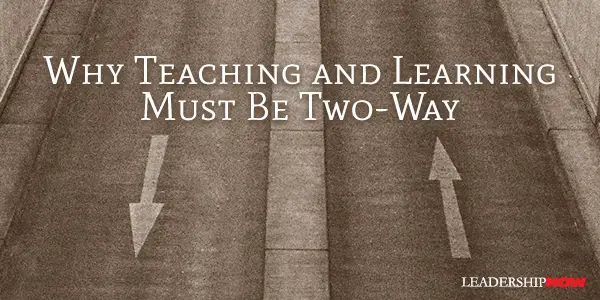
ADDING value and sustaining growth is accomplished by developing others to lead at every level. Simply put, Noel Tichy writes in The Cycle of Leadership, “The company that fields the better team with the smarter people and has them working most often on the things that create the most value will win out over its competitors.” The way this is done is through an interactive teaching/learning process, not a lecture. Great teaching is a two-way street—both become smarter through interaction with each other. It isn’t about alternating roles. You teach me something, and I’ll teach you something. Rather, it is a process of mutual exploration and exchange during which the “teacher” and the “learner” become smarter. Interactive teaching/learning is a critical skill, and it springs from a curious mind. It comes across as freshness and openness on the part of the leader. Executive coach Art Petty leverages this idea in his workshops. He wrote, “Every individual comes to a program with a unique perspective and experiences, and together, we look for common themes and threads we can mine to help all of us.” And Art often shares those insights on his blog. One-way teaching is a natural way of thinking about leadership development. But it limits us as we share only our perspective and often miss the new dynamics that the current reality places on the organization. The hierarchical teacher foregoes the opportunity to grow and learn. Ironically, the more we learn, the less we think we need to know. We become knowers and not learners. But the more we learn, the more we should see the need to explore more and learn more. Leadership is learning at all levels, or it is not leading. When teaching and learning are two-way, we all learn.
Posted by Michael McKinney at 08:57 AM
07.13.23

Leading Thoughts for July 13, 2023
IDEAS shared have the power to expand perspectives, change thinking, and move lives. Here are two ideas for the curious mind to engage with: John Mattone on the importance of critical thinking: “Much of your natural thinking as a leader, when left unchecked, is biased, distorted, partial, uninformed, or downright prejudiced. Your effectiveness as a leader, however, depends precisely on the quality of your thoughts. Critical thinking is that mode of thinking, about any given subject, in which you, the thinker, improve the quality of your thinking by skillfully taking charge of its very structures and imposing intellectual standards upon them. Effective critical thinking, however, involves consideration of the full range of possibilities to a problem, including emotional, cognitive, intellectual, and psychological factors.” Source: Intelligent Leadership: What You Need to Know to Unlock Your Full Potential Tiffani Bova on the need to focus on input metrics to get at the source of problems: “When businesses realize they are falling short in delivering great employee and customer experiences, they tend to make the same mistake: they set out to fix the problems without really knowing why they are coming up in the first place. Without data, companies don’t have the ability to determine causes. Unfortunately, that doesn’t stop many of them from moving forward with important strategic decisions. By focusing on symptoms before diagnosing causes, they overlook the actual problems that, inevitably, continue to cause trouble in measurable or, worse, hidden ways.” Source: The Experience Mindset: Changing the Way You Think About Growth Look for these ideas every Thursday on the Leading Blog. Find more ideas on the LeadingThoughts index.
Posted by Michael McKinney at 07:57 AM
07.10.23

5 Leadership Lessons: Larry Thornton: Reflections on a Fifty-Year Journey from the Segregated South to America’s Board Rooms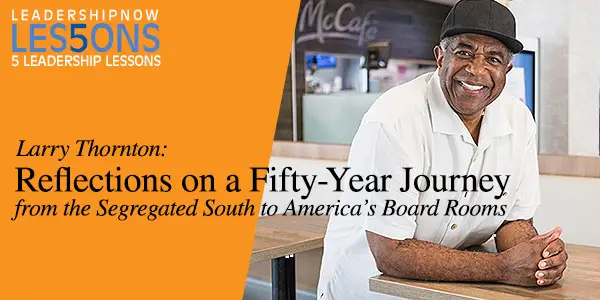
ARTIST AND ENTREPRENEUR Larry D. Thornton says growing up with brown skin in the 1960s in segregated Montgomery, Alabama, he was “socially and internally maladjusted.” He was often angry because “for every single day, essentially everything around him reminded him that he was inferior for no other reason than being born.” He says, “For that reason, I rejected school and disregarded and discounted people with white skin. It was a dangerous road I was on, and I was headed along full throttle.” But over time, his thinking changed due to the caring people around him that provided encouragement. He decided, why not win. “Today,” he writes, “I know that my change in thinking rewrote my history. Since then, I have been immensely fortunate and blessed with a wealth of opportunities—beyond my imagination and more than I deserve.” Beginning as a sign painter for the local Coca-Cola bottling company, he would become the first and only African American to serve on the company’s board of directors. He was also the first African American to own a McDonald’s franchise in Birmingham, Alabama, among other firsts on his journey. In Why Not Win? Reflections On a Fifty-Year Journey from the Segregated South to America’s Board Rooms – And What It Can Teach Us All, Thornton shares stories from his life and pulls the key lessons that shaped him into the person he is today. Here are only five of the 21 life lessons Thornton shares with us:

Posted by Michael McKinney at 06:37 AM
07.07.23

Learning to Manage the Map Paradox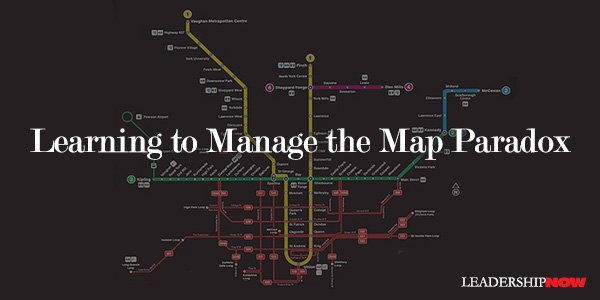
WE ALL HAVE mental maps that we use to explain the world as we experience it. They also provide us with a guide to our actions. But here’s the thing. These mental maps are based on yesterday. Donald Sull calls it the Map Paradox. In The Upside of Turbulence, he writes, “In a turbulent world, people must make long-term commitments based on a mental map they know to be flawed. The paradox arises in any situation where progress requires both long-term commitments from many people and adaptation to changing circumstances.” All mental maps are static representations of a shifting situation, simplifications of a complex world made without the benefit of knowledge that will only emerge in the future. They remain always and everywhere provisional, subject to revision or rejection in light of new information. The paradox of the map demands a delicate balance between commitment and revision, stability and flexibility. Striking the balance is difficult, but possible. Of course, mental maps come in all varieties. There are mental maps that are based on values that anchor us no matter what the circumstances present us with. We all possess personal mental maps that are based on the interpretation of our experiences in life so far. These kinds of maps are often subject to revision as we grow, understand more, and gain new perspectives. All mental models are working hypotheses. Whether your mental maps are explicit or implicit, they all perform three specific functions: “They emphasize important categories, clarify relationships among variables, and suggest appropriate action.” Mental maps create biases. As we take our maps into the future—especially an uncertain future (as most futures are)—they are subject to revision when scrutinized under the light of tomorrow’s reality. Our working hypotheses “provide imperfect representations of a complex and fluid world.” The best way to avoid the Map Paradox is to continuously place your mental model up against models that are different from yours. Look for clues as to what does not support your view of the world. Consider a revolution of thought rather than simply rationalizing away the incongruities you find. Entrepreneurs often find themselves in the Map Paradox because once they build a mental model around their idea, they look for supporting information and fall prey to what they do not know. “A systematic study of three hundred start-ups found that persisting with the initial business plan was the best single predictor of failure one year after founding—nine of ten entrepreneurs who stuck to their initial business plan without revision failed.” Mental models are a necessary part of who we are. They help us to move efficiently through life, but we need to learn to manage them so we aren’t derailed by them in the reality of changing circumstances. 
Posted by Michael McKinney at 10:39 AM
07.06.23

Leading Thoughts for July 6, 2023
IDEAS shared have the power to expand perspectives, change thinking, and move lives. Here are two ideas for the curious mind to engage with: John Bogle asks us what rabbit we are chasing: “[We need to] ask ourselves whether we’re chasing the fake rabbit of success or the real rabbit or meaning, defined by the contributions to our society that stem from principle, virtue, and character. Source: Enough. True Measures of Money, Business, and Life Noel M. Tichy on the need to produce leaders at all levels: “Leadership is the whole game. No institution—religious, military, educational, political or business—can be great unless it has a great leader at the top who develops leaders at all levels of the organization. The goal is leaders at all levels who all teach and develop other leaders.” Source: The Cycle of Leadership: How Great Leaders Teach Their Companies to Win Look for these ideas every Thursday on the Leading Blog. Find more ideas on the LeadingThoughts index.
Posted by Michael McKinney at 08:34 AM
07.03.23

5 Tips for Leading Change: The End is the Beginning
I LOVE ACTION! It’s my favorite part of every movie. Irrevocable decisions will be made. Heroes will push things beyond what’s reasonable. There will be no going back. As exciting as that is for movies, it’s too often a fatal move in business. When leadership decides on a change — a new app, or a new process to help customers — everyone wants to get moving so that they can realize the anticipated results as soon as possible. However, you can’t successfully lead change without having a clear destination. In the rush to demonstrate that action is happening, that’s a simple point too often missed. Quick wins can lead to big losses if we are not moving in the right direction. Clarity on the goal eliminates confusion, sets guidelines for tactics, and avoids wasted time and effort. But we can’t pursue just any direction. The end goal needs to make sense and appeal to the people you are leading. Given that different people have different priorities — and we act in our own self-interest — the challenge is getting everyone aligned and moving in the same direction. Here are five proven tips for leading change by starting with the goal: 1. Set a singular goal: Set a single overarching goal for the change. Make it as clear as possible. Change cannot be about one hundred things. It must have a single, clear focus that encompasses varied interests while being resilient enough to withstand shifts in circumstances. 2. Stay high level: We want to be clear on the destination, but not so specific that it doesn’t allow for adjustments. Keep the goal at a high enough level to allow for the inevitable changes that come as you begin moving forward. This allows for different approaches to achievement. 3. Include the basic details: When announcing the goal for change, the first two things that your audience wants to know is what the change is (the goal) and then how it applies to them. Tackle the basics by including all that the goal entails: the who, what, why, when, and where: Where are we going?
4. Paint the picture: There’s a difference between telling them the facts and telling them a story. Sharing the goal in the form of a narrative that illustrates what the future will be like once the change is in place has the biggest positive impact on people for motivation and buy-in. How will customers’ lives be different? How will life change for employees? When you roll out a new change, it’s common to still be mapping out the journey — how it will be accomplished. Tell your audience that the details are coming and give them a timeline. It’s more important to get them thinking about the goal while you are still working out the details. 5. Highlight the benefits: Highlighting the benefits of the change infuses it with purpose, making it easier for people to support. Your audience needs to know that the change process is worth it. Connecting the goal with benefits for each person is an important motivator. Connecting the goal with benefits for others can be even more powerful. A change that helps those around us offers purpose and meaning to our lives, a common desire for everyone. There’s one more element of change leaders should keep in mind. Nothing great or noble is accomplished without giving up something else. In that element of sacrifice, there may also be some pain. Consider what happened during the pandemic, when so many businesses found themselves making sudden but necessary changes to protect their workforce. Life went through sudden changes as well: Families had to sacrifice their plans, kids went to school from home, marriages were delayed, social connections were lost. For some, the sacrifice was even more than that. As a leader, it’s important to be sensitive to the negatives as well as the positives a change may bring. Better to call that pain out early and often and help people prepare. Laying out the goal clearly enables people to begin processing the reality of the change and the pain it may bring — so they are ready for what comes next. Leading change is a noble calling. People want to know they can trust the person who is directing the charge. Before jumping into the action, take time to set a clear goal.  
Posted by Michael McKinney at 07:04 AM
07.01.23

First Look: Leadership Books for July 2023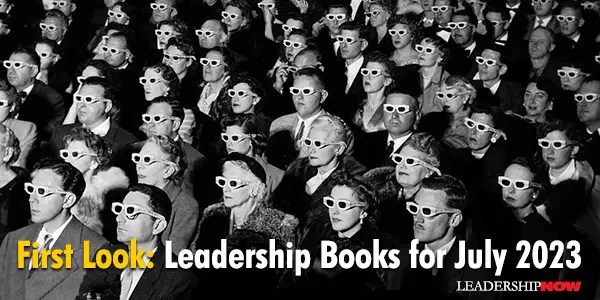
HERE'S A LOOK at some of the best leadership books to be released in July 2023 curated just for you. Be sure to check out the other great titles being offered this month.
The chasm separating managers from leaders is widening as the skills required to be an effective leader grow in number and complexity. But you're ambitious. You want to cross that chasm. And your organization needs you to cross it in order to join its bench of stars who will lead with empathy and humanity and ground the organization's strategies in a meaningful, mission-driven, and purposeful way. The Leap to Leader is your trusted playbook for making the biggest jump of your career. You'll learn from more than a hundred successful leaders who share their powerful insights and compelling stories of how to make the leap, along with practical strategies and tactics for building a loyal following, moving up quickly to broaden your impact, and making the subtle but crucial mindset shifts that are required to lead others effectively.
Leaders don't have to choose between relationships and results! Sadly, compassion and accountability are too often in tension —leaders feel they have to pick one or the other. But solely prioritizing accountability can create toxic work environments that drive away good talent. On the other end of the spectrum, being too nice can compromise performance and productivity. Finding harmony between compassion and accountability is the ultimate catalyst for improved results and a thriving workplace. The solution is recognizing that compassion and accountability are not opposites. In fact, accountability is an element of compassion. Compassionate Accountability is the process of building connection while getting results.
In Leading Through Disruption, Andrew Liveris provides a new leadership paradigm for resilience and agility in a rapidly changing world. This book is a must-read guide for leaders in various sectors who are keen on not only ensuring current success, but protecting the planet’s future for everyone. Liveris, who was recently chosen to lead the Brisbane 2032 Olympic Organizing Committee and is former Chairman and CEO of The Dow Chemical Company, presents a variety of powerful tools that will enable you to tackle any problem quickly and responsively, with an eye to creating a more equitable, sustainable future.
If you're thinking of cutting your midlevel managers in the new world of work, think again. "Middle manager." The term evokes a bygone industrial era in which managers functioned like cogs in a vast bureaucratic machine. In recent decades, midlevel managers became a favorite target for the chopping block—underappreciated, often considered a superfluous layer of the organization. Not only does this outdated perspective need to change, but the future demands it. In Power to the Middle, McKinsey thought leaders Bill Schaninger, Bryan Hancock, and Emily Field call for a profound reimagining of managers and their roles. They explain how middle managers are uniquely positioned close to the ground but with a crucial connection to company strategy, enabling them to guide their organizations through periods of rapid and complex change, as well as to help shape the new world of work.
James Burstall runs one of the most successful TV production companies in the UK. But during his tenure at Argonon he has had to deal with a variety of existential crises. Through them all, he's managed to guide his team out the other side successfully. Whether it's been the credit crunch or terror attacks. Recessions. Natural disasters. Pandemics. The TV industry has felt the strain of these recurring events like all of us. And each time, James has put strategies in place in order to be prepared for the next time something like this happens: because it will happen again. In 16 concise lessons, hard won from real-world experience, this book uses practical examples to demonstrate how we can turn disasters into opportunities. Though painful, shock events can actually be good for us. It is possible to turn venom into rocket fuel! We can survive crises and thrive.
Here is one of the most fundamental questions in human life: How do we decide how we decide? We make such decisions all the time. If you trust your doctor, you might decide to follow a simple rule for medical decisions: Do whatever your doctor suggests. If you like someone a lot, and maybe love them, but are not sure whether you want to marry them, you might do this: Live with them first. Some of these strategies are wise. They prevent error. They improve your emotional well-being. Some of these strategies are foolish. They lead you in the direction of terrible mistakes. They prevent you from learning. They might make you miserable. Decisions about Decisions explores how people do, and should, make decisions about decisions. It aims to see what such decisions are, to explore how they go right, and see where they go wrong.
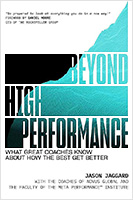   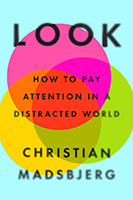
“... a mind needs books as a sword needs a whetstone, if it is to keep its edge.” — George R.R. Martin, A Game of Thrones
Posted by Michael McKinney at 06:16 AM
|
BUILD YOUR KNOWLEDGE


How to Do Your Start-Up Right STRAIGHT TALK FOR START-UPS 
Grow Your Leadership Skills NEW AND UPCOMING LEADERSHIP BOOKS 
Leadership Minute BITE-SIZE CONCEPTS YOU CAN CHEW ON 
Classic Leadership Books BOOKS TO READ BEFORE YOU LEAD |
|